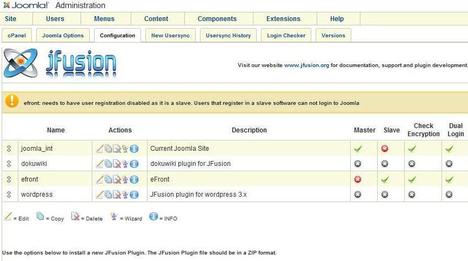We worked lately on a very exciting project. The project consisted of integrating eFront, the well known Learning Management System (or LMS), with Joomla, the very famous Content Management System (CMS). In short our client wanted to do the following:
- Ensure that the users tables are synchronized, where Joomla is the master and eFront is the slave, which means that if a new profile is added to Joomla, it is added to eFront as well, but not the other way around.
- Ensure that the login is unified between the two, which means that if a person logs in to Joomla, he will be logged in to eFront.
- Ensure that eFront can be accessed from within the Joomla website.
Of course, this is a challenging job since both Joomla and eFront are totally separate systems, and integrating eFront with Joomla will be a very difficult task. However, there is a very useful extension on Joomla called JFusion. JFusion allows the integration of 3rd party applications with Joomla, including eFront.
So, the first thing that we did was to install JFusion. JFusion’s installation is very simple and straightforward:
- Download the JFusion extension
- Install the extension using the extension manager
- That’s it!
After installing JFusion, we moved on to install eFront. Here’s what we did to install eFront:
- Download eFront
- Upload it to a directory called edu on the server (just under the public_html directory) and then extract it there
- Go to http://ourclientjoomlawebsite.com/edu to configure eFront
There’s a caveat that one needs to be aware of when installing eFront: eFront’s table prefix functionality is deprecated, which means that it’s preferable to choose an empty database to support the database layer of your eFront installation (e.g. when you are prompted to add your database credentials, ensure that you are not using the database used by your Joomla website, but rather an empty database – this is not necessary but it is precautionary in case your Joomla database has some tables without prefixes).
After installing both JFusion and eFront we arrived to the fun part: integrating eFront with Joomla. To do this, all we needed to do was to go to JFusion and configure the eFront plugin to make it point to the right URL and the right path. We also needed to provided an API User and an API Key (the API User and the API Key are just the username and password of an admin created on eFront). We then needed to provide the database credentials for eFront (so that JFusion can connect to the database and store/update/retrieve information from there).
We have to say that the first time we tried to set up eFront on JFusion it didn’t work, but we tried to do it using the wizard and it worked (we were first trying to do it manually).
Once the mission of setting up eFront with JFusion we needed to specify how eFront should be integrated in Joomla to accommodate our customer’s needs. That was easily done by going to the main JFusion configuration page, and then clicking on the Master icon next to Joomla, and then clicking on the Slave icon next to eFront. Once that was done, the JFusion configuration page looked like the following:

Now the final part was to create a menu item to point to eFront from within Joomla. All we needed to do was to create a new menu item, and then choose the menu item type to be JFusion, and then choose the eFront plugin from the drop down on the left side. (Needless to say, we also needed to specify the menu item title and other “standard” parameters).
At this point we had eFront fully integrated with Joomla. All we needed to do was to test:
- We created a new profile on Joomla and we checked eFront’s admin and it was indeed creating the same user on eFront.
- We logged in on Joomla using the user we just created and we were automatically logged in on eFront.
- We were able to see eFront by clicking on the menu item that we created above.
Although the guide above seems straightforward, it is very possible to face some challenges when you try to integrate eFront with Joomla. If you do, then all that you need to do is contact us and we will definitely help you. We are fast, we are reliable, we are friendly, and we don’t charge much!

[…] sh404, JomSocial, JFusion (yes – JFusion can be quite complicated – check this post on eFront’s integration with Joomla), […]